The argument from perishable beings
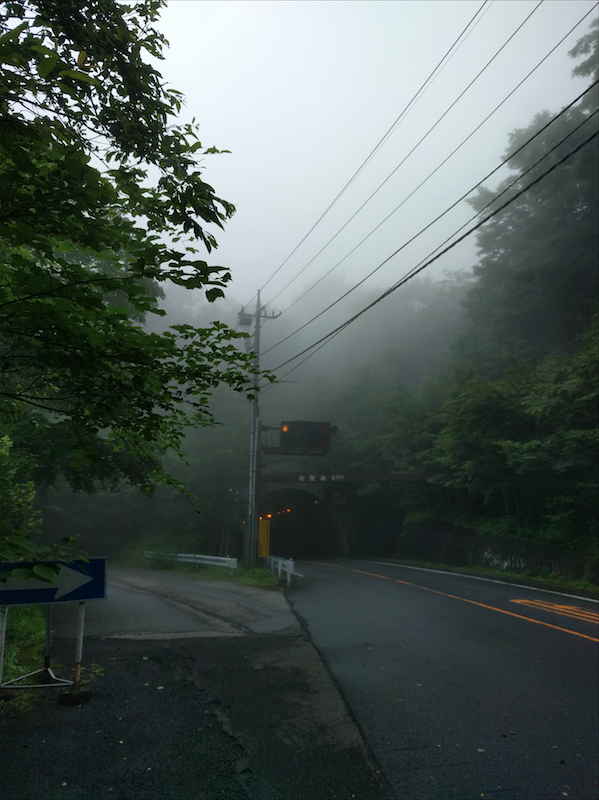
About an hour’s bus ride from Nikko station, over Daiya river and the candy apple arc of Shinkyo bridge, through Nikko’s dusty outskirts, Kiyotaki, then the tunnels and switchbacks which surmount the Akechidaira plateau, you come to a small town wedged between a sacred lake and a sacred mountain. Chuzenjiko (中禅寺湖) translates to “lake of the Chinese zen temple”, while the mountain, Nantai (男体), means “man’s body”. In a perverse literalism, for over a thousand years, the region was closed to horses, women, and cows.
The town is sometimes called Chuzenji, sometimes Okunikko (奥日光, “inner Nikko”), and even in this ambiguity seems more defined by its proximity to other things than any properties of its own. It is in between, or nearby, but never “here”. The day my bus rolls up the mountain and into the carpark, it is swaddled in a blanket of fog and almost invisible, in all directions but nowhere to be seen. Initially, Chuzenji was no more than a pitstop on my way to the Senjogahara marshland, a sprawling plain of hare’s-tail cottongrass and rambling boardwalks 1400 meters above sea level and 20 minutes down the road. But the mass of cloud has settled onto wetland and lake, dampening my plans for a hike. I decide to explore the town instead.
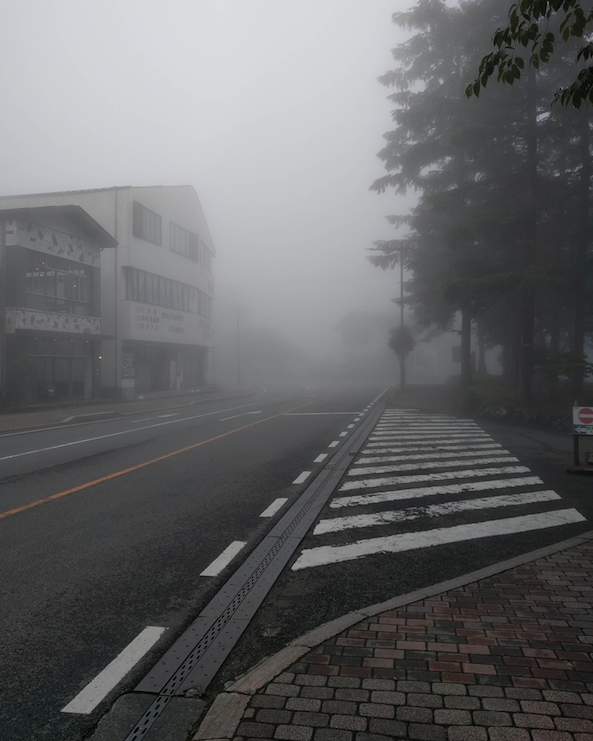
Chuzenji forms a loose “V” between two waterfalls and the eponymous buddhist temple, cluttering the intervening lakeside with jetties, hotels, souvenir stores, embassies, and mom-and-pop kitchens, in various states of closure and disrepair. Off-season it may be, but for the lugubrious pensions and noodle shops, it is off-season forever. With its qualities of supernumerary variety and fantastic decay, Chuzenji reminds me of flotsam, washed up on the shore by the 80s boom and left to rot in the downturn of the 90s. These crumbling facades chart not only the ravages of time, but the rise and fall of the Nikkei.
By the cruise terminal, I pause and imagine the 80s daytrippers pouring in from the suburbs of Tokyo, all chinos and sweatpants and big hair. They flit wordlessly about the streets to watch the glassblower at work, unironically chow down on Nikko World Heritage Cheese Eggs, and take a turn on the cygnine pleasure crafts. The fantasy

The swan is not the town’s only familiar. Along the main road is Lake Garden (レイク・ガ-デ ン), a sprawling complex once offering travellers the threefold amenity of omiyage (souvenirs), teppanyaki, and hotel. Long abandoned, it now offers little more than a dereliction of weeds, rust, and lace curtains out of a horror film. In the ghostlight of times past, the family troops into the restaurant and Otousan relishingly helps himself to three huge slices of Kobe beef, while Oneesan, a light eater, watches on with disapproving fascination. This tableau fades once more into peeling wallpaper and disconsolate heaps of furniture.
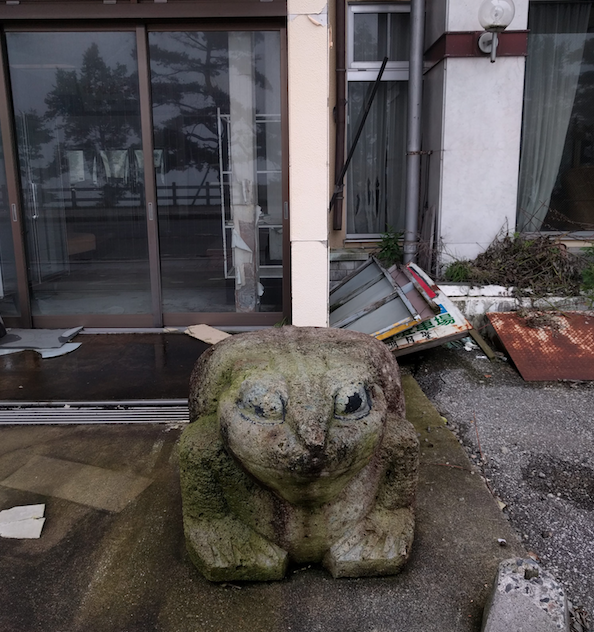
The hotel is flanked by two seemingly incongruous figures: a stone toad and a wooden owl. The toad is huge, coarse, and discoloured by mould. It reminds me of the dogs with eyes as big as saucers that, in the Danish fairytale, the soldier could summon with a tinderbox. Like the dogs, the toad would have been more at home in the dank of a well than the carpark of a teppanyaki joint. But even stranger than the eyes is the delphic smile drawn thinly across its face, giving it the appearance less of a toad and more a hunched anthropoid or sphinx. It awaits an answer.
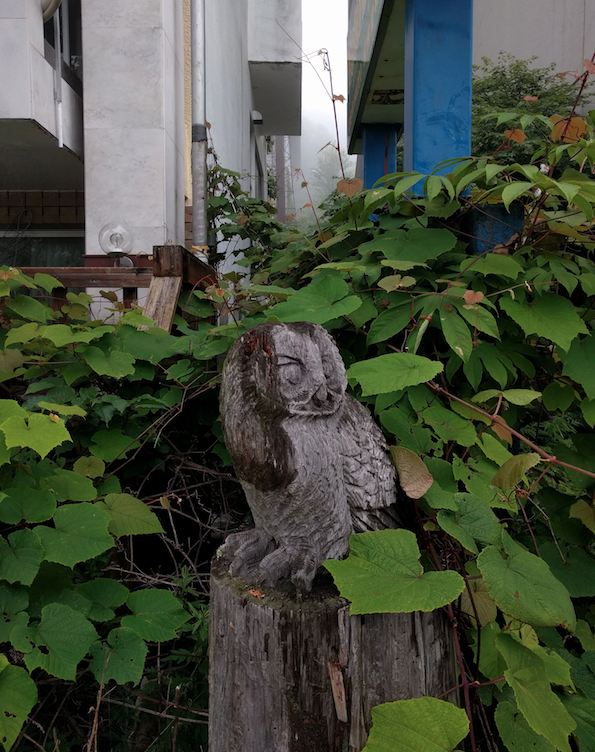
The owl, on the other side of hotel’s main frontage, is perched on the stump of the tree from which it was carved. It pauses, head cocked expressively, as if it had just heard the rustle of a vole in the undergrowth. It is altogether less disquieting than the toad, or the swan, more explicable, and with its air of quiet alertness and rustic handicraft, sounds a comforting note.
Old stuff
But I suspect these distinctions and categories are Occidental, belonging to me and not to the objects themselves. There is a secret oneness between the animals, some thread which ties them together, and to the fate of the town, but which is as yet obscure to me.
It is a guard rather than a sphinx or an apparition beneath a well. But these Occidental distinctions and categories seem to miss
The hotel is flanked by two apparently incongruous figures: a stone toad and a wooden owl. In the light of another time, I imagine our daytrippers staying here: otouto finds a small wooden plane in the souvenir store; Otousan relishing his Kobe beef; oneesan bored by the whole affair.
Two guardians, a stone frog and keep watch over the ruin: a frog and an owl. Their presence is melancholy and yet somehow comforting.
(More on buildings, frog, owl. Perhaps Hotel Asian?)
Among these melancholy and disquieting creatures, I begin to ponder the nature of ruin. Is it mere grotesquerie, like the swan, things disharmonious in the arrangement of their parts? That would make it an aesthetic judgment like beauty, and in a way, ruin is beautiful, or at least, arresting in some gropingly analogous fashion. But disharmony is different from beauty, since easier to achieve; to paraphrase the opening lines of Anna Karenina, or the second law of thermodynamics, there are many more ways to fall apart than not. Harmony is a vanishing sliver of phase space; ruin is the freedom of matter from human conceit.
Now, this democratic view suits the parts, the rusting staircase and the peeling paint, who are ignorant of decline and know only combinatorics. But the assemblage does not have this luxury: when an organism is sufficiently disarranged, it dies; when a building decays and collapses, it is no more; if the daytrippers stay home, and the swans lose their heads, and folk move away, a bustling settlement becomes a ghost town. Ordered composites can only exist and operate in tiny slivers of phase space. Ruin is a statement about the perishability of ordered being.
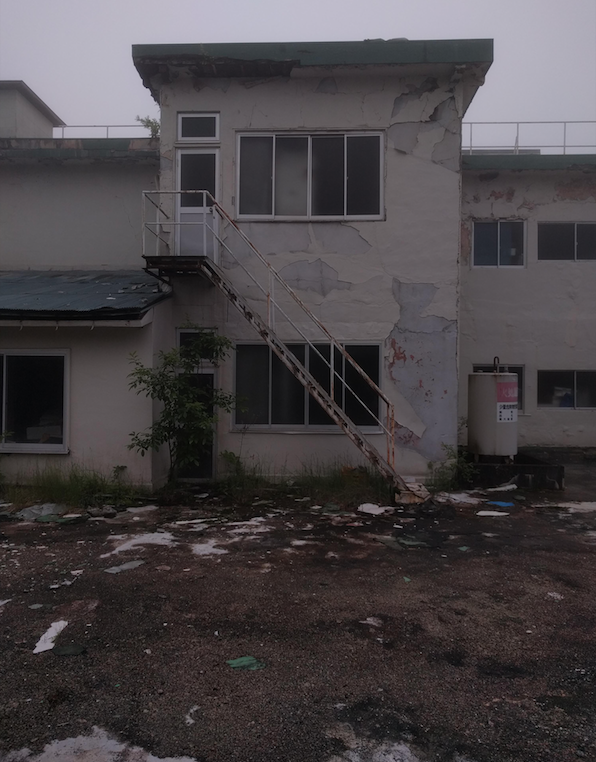
Curiously, the great theologian Thomas Aquinas saw in this perishability a proof of the existence of God. In his Tertia Via (Third Way), he argues that the world is full of perishable orderings—things like boats and people and economic growth—which come into being for a time, but by the agency of death, corruption and change, go out of it again, through a sort of revolving door of ontology. So far, he is in agreement with Heraclitus, the pre-Socratic who pithily observed that nothing endures but change.
Here, Aquinas makes his bold departure. There is change, there is flux, there is destruction; very well. But what (Aquinas asks) underwrites all that, and revolves the door of ontology? It cannot be the perishable beings themselves, since they disappear and take their causal powers with them. Could a mortal be responsible for Mortality, or something contingent for Contingency itself? Certainly not, he concludes. Something necessary and immortal must keep the machineries of decay ticking over. This Third Way is no route to a Judeo-Christian Father, wrathful or provident as the various Testaments would have us believe; rather, it establishes God as a metaphysical principle of ruin.
(House fire)
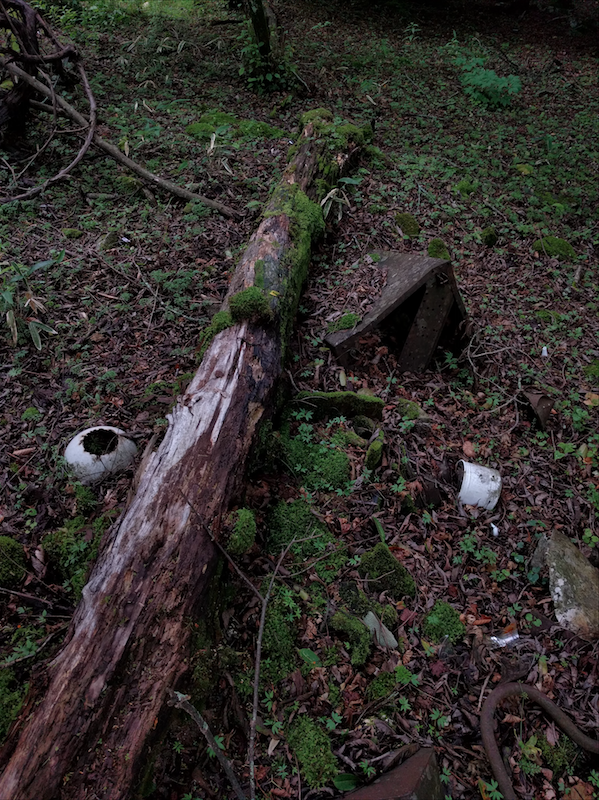
Is there a theodicy of ruin? Some way to reconcile ourselves with contingency and the true vastness of phase space? Here, in one of His dwelling places, I may have the chance to find out. Mist plays over the remains of a housefire, and draws my eye up, towards the hidden peak of Nantai. I am cold. I have no cell reception. I will need a place to sleep.
I passed a konbini in the cruise terminal, so I walk back and dawdle in the snack aisle, wracked by performative indecision, which search for hotels on the wifi. A balding clerk listens to the baseball—from what I can tell, the Swallows are leading the Baystars—and watches me with quiet indulgence. He has nowhere to be and all the time in the world. He yawns, switches stations; I can play at browsing snacks for as long as I like. Perhaps this is the convenience store version of omotenashi, Japan’s famous hospitality, repackaged as a small and portable indifference to my blundering efforts.
Incidentally, this is what forever feels like: a balding clerk listening to baseball scores, while a gaijin picks up one brand of novelty pretzel after another after another, all with the imperturbable slowness of a dream. A convenience store is a good place to visit eternity.

So, I discover Little Forest Inn has rooms. On the northern shore, Chuzenji has a single backstreet, pitched up the hill from the middle of the “V” and running like a droplet back into the lake as the road crawls westward. Little Forest Inn is near this westward fall, cushioned between an enormous shed and an empty weedlot. I leave the convenience store, now armed with an array of pretzels, and cut up a concrete ramp to the backstreet. The weeds form a little forest in poetic apposition to the guesthouse, and I clamber over a fence and down a stone wall to take in its petrichor and glistening tussock before checking in.
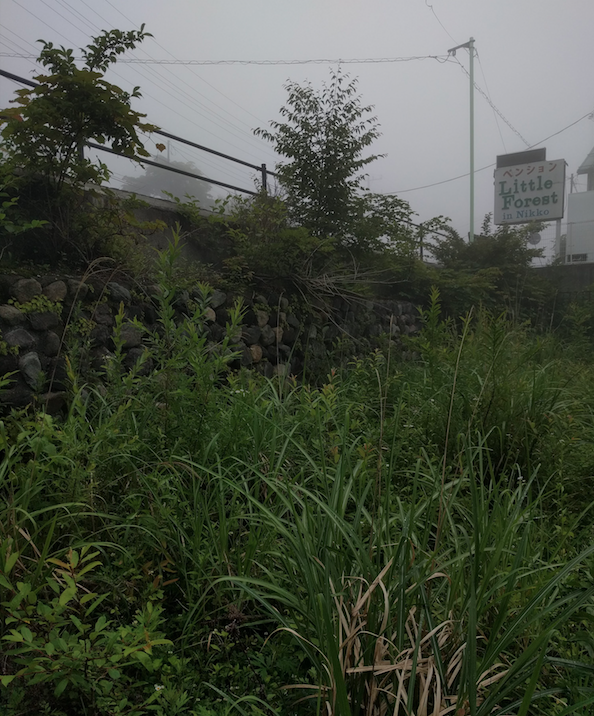
Back at street level, the Little Forest presents an enigma of locked and unmarked doors. I pick one at random and knock quietly; nothing. I knock harder. After a few minutes, a blob appears behind the frosted glass, resolving as the door opens into a thin and slightly frayed woman in her late 30s. She conducts me inside, and, as if to certify a position of which she is unsure, shuffles behind a curtain to then re-emerge and face me with exaggerated formality over the counter. Between her broken English and my broken Japanese, a room is booked. With the infinite solicitude of omotenashi, she unfolds a map and inscribes some points of interest—the temple, the falls, the grocer—in between demotic hesitation markers and regrets for seasonal closures, as if it were a personal oversight not to keep them open for me.
I tramp upstairs to deposit backpack and pretzels, and enjoy a cup of complimentary matcha. Although my window faces the lake, visibility is limited to the terraced dwellings between the back and mainstreets; it looks like the town has floated into the stratosphere. Descending again, a toddler sits on the counter and hands me a set of housekeys, smiling with inexpressible joy at his act of mimicry. The host materialises again to rescue toddler and keys, apologising profusely but not entirely suppressing a smile of her own; a little life peeping through the formality.
I leave the inn thinking about the toddler’s gift: life and its relation to disorder. At first, life seems as incongruous as a teapot I found in the remains of the housefire, an island of order in a sea of chaos. But physicist Jeremy England has suggested the converse: life is not the island of order, but the waves lapping at the shore and gradually dissolving sand into ocean, less like the teapot and more like the blaze that consumed the house. It is a surface phenomenon, evolved in accord with thermodynamics not to preserve order, but to convert it to disorder with maximum efficiency. England calls this “dissipation-driven adaptation”. With enough order to burn, life could be inevitable.
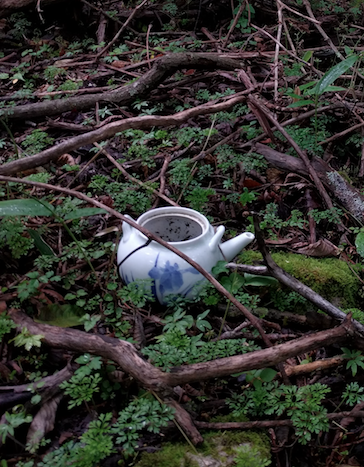
So, say life thrives at the edges of disorder. Is this a theodicy? No; no application of Jarzynski’s inequality, however ingenious, can restore the Library of Alexandria; no judicious separation of scales will raise the dead. Loss is loss is loss, and that we are so wholly creatures of the god of ruin is no comfort. Besides, whatever the facts of life, physics cannot render mechanism into human value, or expiate from first principles. Anyone who has thought about natural selection, for instance, will see that its explanatory elegance cannot be weighed on the same balance as eons of pointless death.
By the ramp, wildflowers sprout through the gravel of a tumbledown plot. At the back is a rusted lean-to. With its air of sabi decrepitude, it reminds me of a makeshift shrine, housing rakes and chain-tires in place of cult objects or the Tablets of Law. (Religion and humour.)
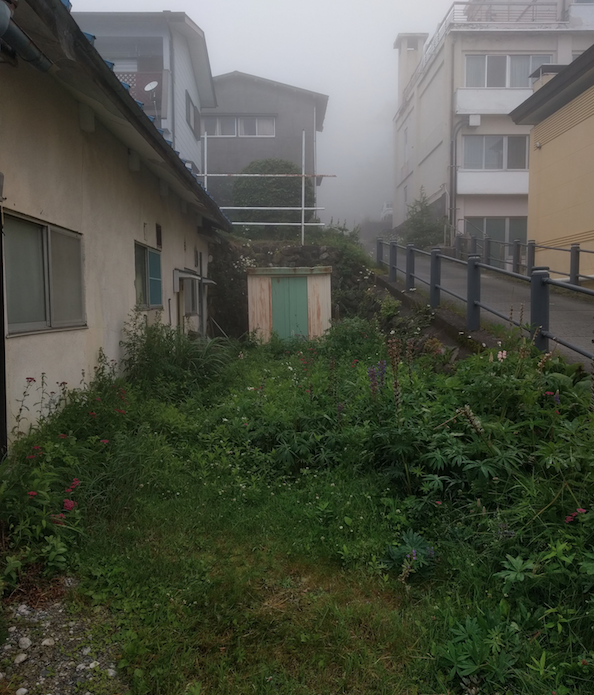
The task of expiation falls to other systems of thought—religion, philosophy, art, humour—with broader responsibilities and margins of error. In Japan, this broader system is aesthetics, https://en.wikipedia.org/wiki/Wabi-sabi https://en.wikipedia.org/wiki/Kintsugi https://en.wikipedia.org/wiki/Mono_no_aware
Extra
Shinto shrine, a celebration of the hidden forces of the world. 惟神の道
In 782, Hashiri Daikokutendo The argument from perishable beings In 782, the Buddhist monk Shodo Shonin (勝道上人) — who had
⁂
https://www.rinnoji.jp/signboard/qr0038.html# a deteriorating tourist town nestled between a sacred lake and a sacred mountain. Lake Chuzenjiko (中禅寺湖) literally means “Lake of the Chinese Zen Temple, while Mt. Nantai (男体) is “man’s body”. Both were closed to women and horses for over a thousand years.
But the scattering of tumbledown hotels, souvenir shops, It gives the lake a sleepy, deteriorating crust of tumbledown hotels, Its chief attraction is the eponymous buddhist temple and its statue of Kannon, the goddess of mercy.
It gives the lake a crust of jetties, tumbledown hotels, souvenir shops, and strangely large emporia in various states of disrepair; washed up on shore, a residue of better times. sort of encrustation along the corridors of travel between the eponymous buddhist temple and two waterfalls.
In a sense, visiting the lake is a particularly vivid lesson
a residue of better times, the 80s boom and the liquidity it freed up for domestic tourism, and the asset price bubble of the 90s
if the brochure was to be trusted.
But fog had descended on the lake and the adjoining plataeaus, so
Initially, it was no more than a pitstop on my way to the Senjogahara marshland
the town that wasn’t there.
spidered with boardwalk
I was in it, but it was nowhere to be seen.
spoiling my designs on the picturesque wetlands
and dots the lakeside
residue of the 80s boom
It is a tourist town washed up on the shore, fantastic flotsam from the 80s boom which freed up liquidity for domestic travel, and came crashing down when the asset price bubble burst in the 90s.
More than the mere passage of time, the crumbling facades chart the rise and fall of the Nikkei.
Chuzenji strings out in a loose “V” around the lake
But the mass of cloud had settled onto the adjoining plateaus,
It is a town washed up on the shore like flotsam, a residue of the boom of the 80s and the collapse of the 90s.
between with jetties, hotels, souvenir stores, high-walled embassies, mom-and-pop kitchens, and oversized emporia,
But the dream fades, and I am left with the dead boats, headless and run aground, looming at me out of the gloaming air.
ike the suspiciously happy families of a Coke ad.
outskirts, Kiyotaki, then tunnels and misty switchbacks up and around the convulsed base of the Akechidaira plateau, you come to a
between with jetties, hotels, souvenir stores, embassies, mom-and-pop kitchens, and oversized emporia,
shattered by the reality of a beached and headless swan; a Chuzenji grotesque.
Either way, there are many ways to be, and only a few happen to please the human eye.
In his Tertia Via, he argues that there are perishable beings, who exist but need not.
dampening my plans for a picturesque hike
As an ordered composite, arranged in ever greater hierarchies of order, we operate in tiny slivers of phase space, and if entropy is maximized, we will cease to exist.
bubble, shattered by the reality of a beached and headless swan;
Does the god of ruin smile on this place? A querent would know.
A convenience store, overflowing as it is with the contingent, is paradoxically one of the best places to experience eternity.
No insights into the nature of contingency and order, however
A convenience store is perhaps the best place to know what forever feels like. It feels like a balding clerk listening to the baseball scores while a gaijin pretends to look at snacks.
rather, it enshrines God as a metaphysical principle of ruin.
Does the god of ruin smile on this place? The only way to find out No insights, however profound, will conjure up a place to sleep.
In his Tertia Via (Third Way), he argues that the world is full of perishable beings, or more generally perishable order, things like boats and people and economic growth.
Here, in one of the dwelling places of this ruinous god, I may have the chance to find out.
existence, and take whatever causative powers they effected with them.
Something imperishable must underwrite this process
It certainly cannot be the perishable beings themselves, since they pass out of existence and take their causal powers with them.
Westward and past the guesthouse when I see the weedlot, a little forest in poetic apposition. I take in the petrichor of the tall, wet grass, and imagines . So much for the marshland.
pitched up the hill at Kegon waterfall in the east (the middle of the “V”)
exaggerated formality over a desk, with its guestbook and brochure.
and a map is shyly embellished with points of local interest.
The woman apologetically retreives the keys, and hands the toddler to a disembodied pair of hands that emerge from the curtain.
has evolved in accord with thermodynamics to dissipate order with maximum efficiency.
better illustration than wildflowers sprouting through the cracks of the tumbledown lot by the backstreet ramp.
is the revolver of the door of being par excellence,
It is a surface phenomenon in phase space, a skin of chaos, which has evolved in accord with thermodynamics not to preserve order but to dissipate it with maximum efficiency; England calls this “dissipation-driven adaptation”.
the pre-eminent revolver of the door. T
The woman materialises and retrieves toddler and keys, apologising profusely. She does not, I notice, entirely suppress a smile of her own.
I head back down to the main street, with thoughts of life, disorder, being and ruin, orbiting about me.
Life may thrive at the margins of disorder, but this is too glib to constitute a theodicy.
a skin of chaos
There is more to life than the sliver of phase space, the island of order in a sea of chaos.
A lean-to at the back reminds of a Shinto shrines dotted over the country, like wild mushrooms in autumn.
Loss is loss is loss, and non-equilibrium processes have no say in the matter.
A lean-to at the back reminds of a Shinto shrine.
Loss is loss is loss, a vacuum we rush headlong into as if our lives depended on it; perhaps they do.
It is a surface phenomenon, a bleeding edge evolved
England calls this “dissipation-driven adaptation”, and it provides a possible physical explanation for life itself.
The fact that we may be rushing headlong into it, as a matter of thermodynamic necessity, does not comfort me.
Life may thrive at the margins of disorder, but this is not a theodicy.
the same way that natural selection, whatever the elegance of its mechanism, cannot
a map of the area inscribed with points of interest—the bus stop, grocer, Italian restaurant—punctuated with the “anos” and “etos” of
my host materialises out of the gloom again to rescue toddler and keys,
Almost as miraculously as the toddler, my host materialises again to
His joy in this small act of mimicry is inexpressible.
Descending again, a toddler has appeared on the counter, and smiling hugely, hands me a set of random keys. His joy in this small act of mimicry is inexpressible.
At first, life seems as incongruous as the teapot I found in the remains of the housefire, an island of order in a sea of chaos.
disorder is also the condition for life.
Even if life thrives at the margins of ruin, this is not a theodicy.
I leave the inn thinking of life and its relation to disorder, as if this were the toddler’s true gift.
Even if life thrives at the margins of ruin, this is not a theodicy.
I head back down to the main street, no plans in mind, nothing for life to nibble away at.
the ordinary necessities of sleeping and eating and loving
I hit the main street with no plans in mind, nothing for life to nibble away at.
Spheres within spheres.
But the rusty lean-to at the back gestures towards other forces. A box, by construction, conceals void;
the ordinary necessities of human existence.
Presiding over this growth is a rusted lean-to, concealing in all probability nothing more exotic than rakes and tire-chains. But I am reminded of the Shinto shrines that dot the country like autumn mushrooms, and something about the lean-to, in its state of sabi decrepitude, gives it the air of a makeshift altar.
At the back, a rusted lean-to seems to carry these thoughts and their momentum along the linear strip of growth and into different territory altogether.
, a bleeding edge between order and chaos
crumbling staircase and the peeling wallpaper, who are ignorant
Loss is loss is loss, and when order runs out, so does life.
But perspective guides my thoughts along this linear strip of growth to the rusted lean-to
a representative instance of England’s hypothesis.
It is concealed presence, and comparing
But the lean-to might also contain fertiliser, or swan heads, or nothing at all.
My eyes run along the linear strip of growth to the rusted lean-to at the back.
a perfect specimen of the Chuzenji grotesque.
lace crumbling sinisterly behind the oddly clean windows.
(Even less explicable is the marooned dinghy, almost hidden by vines.)